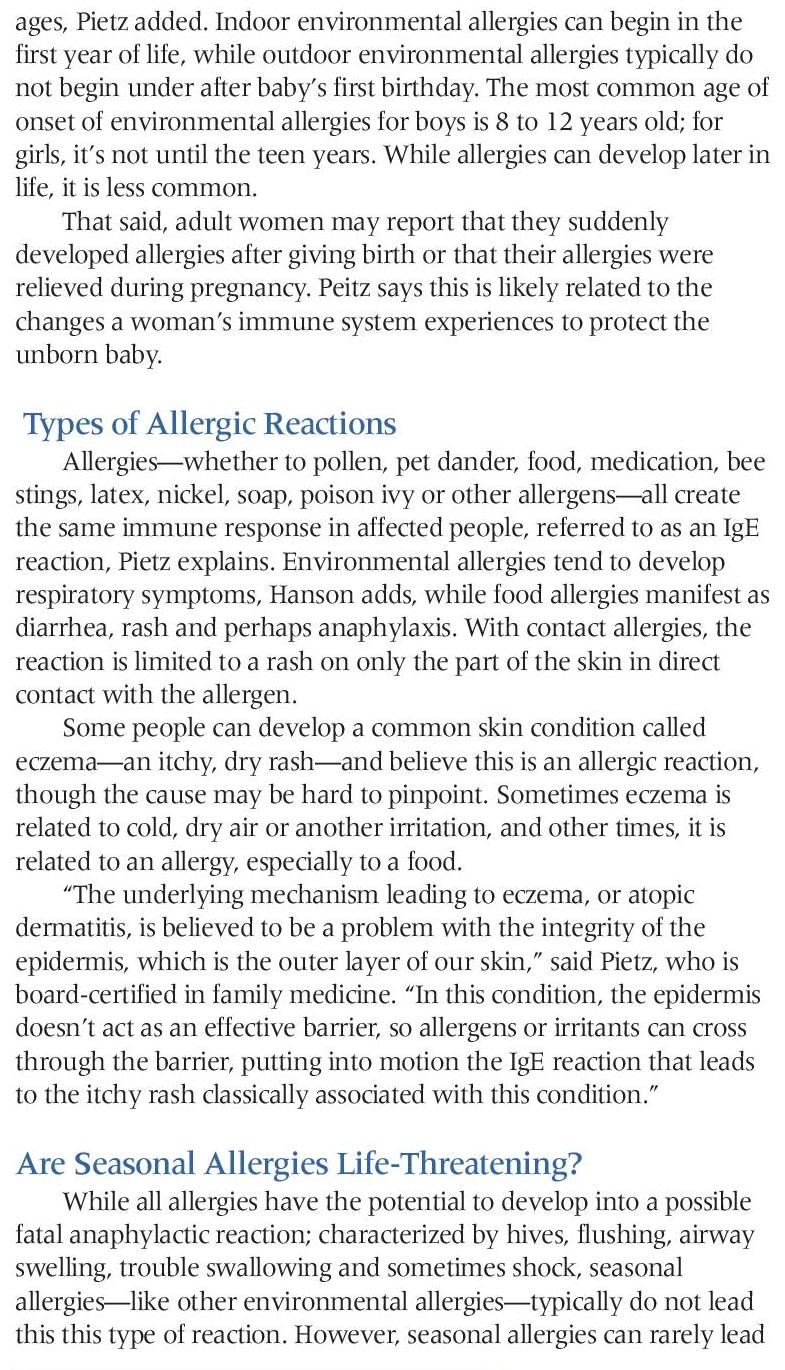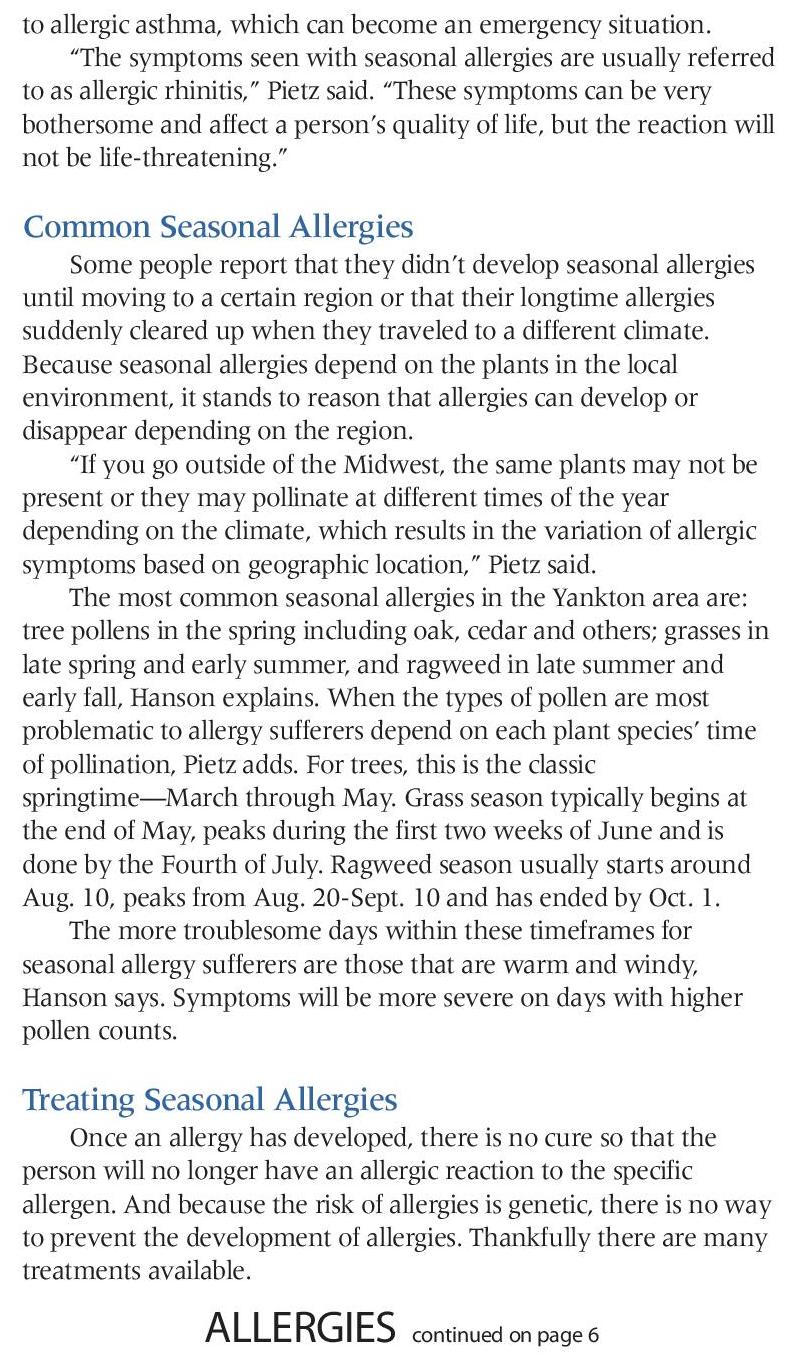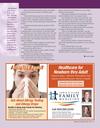5



ages, Pietz added. Indoor environmental allergies can begin in the
first year of life, while outdoor environmental allergies typically do
not begin under after baby’s first birthday. The most common age of
onset of environmental allergies for boys is 8 to 12 years old; for
girls, it’s not until the teen years. While allergies can develop later in
life, it is less common.
That said, adult women may report that they suddenly
developed allergies after giving birth or that their allergies were
relieved during pregnancy. Peitz says this is likely related to the
changes a woman’s immune system experiences to protect the
unborn baby.
Types of Allergic Reactions
Allergies—whether to pollen, pet dander, food, medication, bee
stings, latex, nickel, soap, poison ivy or other allergens—all create
the same immune response in affected people, referred to as an IgE
reaction, Pietz explains. Environmental allergies tend to develop
respiratory symptoms, Hanson adds, while food allergies manifest as
diarrhea, rash and perhaps anaphylaxis. With contact allergies, the
reaction is limited to a rash on only the part of the skin in direct
contact with the allergen.
Some people can develop a common skin condition called
eczema—an itchy, dry rash—and believe this is an allergic reaction,
though the cause may be hard to pinpoint. Sometimes eczema is
related to cold, dry air or another irritation, and other times, it is
related to an allergy, especially to a food.
“The underlying mechanism leading to eczema, or atopic
dermatitis, is believed to be a problem with the integrity of the
epidermis, which is the outer layer of our skin,” said Pietz, who is
board-certified in family medicine. “In this condition, the epidermis
doesn’t act as an effective barrier, so allergens or irritants can cross
through the barrier, putting into motion the IgE reaction that leads
to the itchy rash classically associated with this condition.”
Are Seasonal Allergies Life-Threatening?
While all allergies have the potential to develop into a possible
fatal anaphylactic reaction; characterized by hives, flushing, airway
swelling, trouble swallowing and sometimes shock, seasonal
allergies—like other environmental allergies—typically do not lead
this this type of reaction. However, seasonal allergies can rarely lead
W h en co lo n
ca n cer is fo u n d
ea rly th e ch a n ce
o f bein g cu red is...
N ea rly 100%
••••••••
Last year,160 So u th
Dako tan s lo st th eir lives
to co lo recta lcan cer.*
to allergic asthma, which can become an emergency situation.
“The symptoms seen with seasonal allergies are usually referred
to as allergic rhinitis,” Pietz said. “These symptoms can be very
bothersome and affect a person’s quality of life, but the reaction will
not be life-threatening.”
Common Seasonal Allergies
Some people report that they didn’t develop seasonal allergies
until moving to a certain region or that their longtime allergies
suddenly cleared up when they traveled to a different climate.
Because seasonal allergies depend on the plants in the local
environment, it stands to reason that allergies can develop or
disappear depending on the region.
“If you go outside of the Midwest, the same plants may not be
present or they may pollinate at different times of the year
depending on the climate, which results in the variation of allergic
symptoms based on geographic location,” Pietz said.
The most common seasonal allergies in the Yankton area are:
tree pollens in the spring including oak, cedar and others; grasses in
late spring and early summer, and ragweed in late summer and
early fall, Hanson explains. When the types of pollen are most
problematic to allergy sufferers depend on each plant species’ time
of pollination, Pietz adds. For trees, this is the classic
springtime—March through May. Grass season typically begins at
the end of May, peaks during the first two weeks of June and is
done by the Fourth of July. Ragweed season usually starts around
Aug. 10, peaks from Aug. 20-Sept. 10 and has ended by Oct. 1.
The more troublesome days within these timeframes for
seasonal allergy sufferers are those that are warm and windy,
Hanson says. Symptoms will be more severe on days with higher
pollen counts.
Treating Seasonal Allergies
Once an allergy has developed, there is no cure so that the
person will no longer have an allergic reaction to the specific
allergen. And because the risk of allergies is genetic, there is no way
to prevent the development of allergies. Thankfully there are many
treatments available.
ALLERGIES
continued on page 6
Colorectalcancer is n ea rly 100% treatable w hen caught at an early
stage!According to the Centers for Disease Control,screening and
rem ovalofprecancerous polyps can reduce the num ber ofdeaths from
colorectalcancer by 60% !O ver one third ofSouth Dakotans do no
participate in screenings.
Co lo recta lca n cer is preven ta ble!
5 0 o r o ld er? G et Screen ed !
The recom m en dation for colorectal can cer screen in g is a blood stool test
every year or a sigm oidoscopy/colon oscopy every 10 years for person s age
50 years of age or older.*
Ca ll668.9670 fo r m o re
in fo rm a tio n o r to a rra n ge
yo u r co lo n o sco py to d a y.
w w w .yan kton surgical.com
*Source: Colorectal Cancer in South Dakota 2012, Project In Check, South Dakota Council on Colorectal Cancer.
Lew is & Clark M edicalPlaza,
2525 Fox Run Parkw ay,Suite 204,
Kynan C.Trail M D,FACS
,
Yan kton SD
HERVOICE MARCH/APRIL 2014 v 5



























 Previous Page
Previous Page

